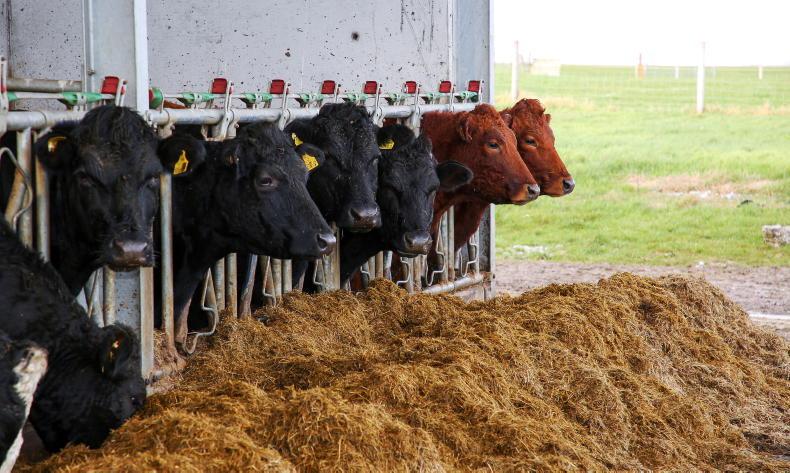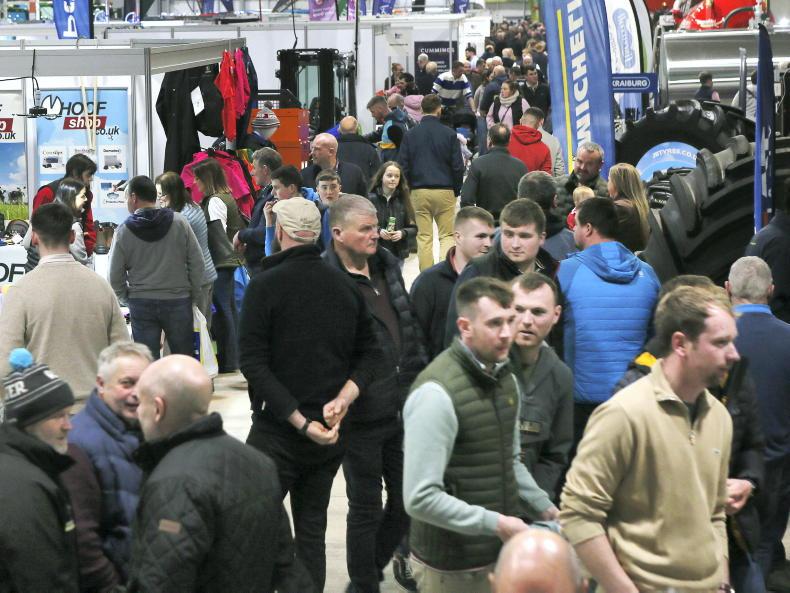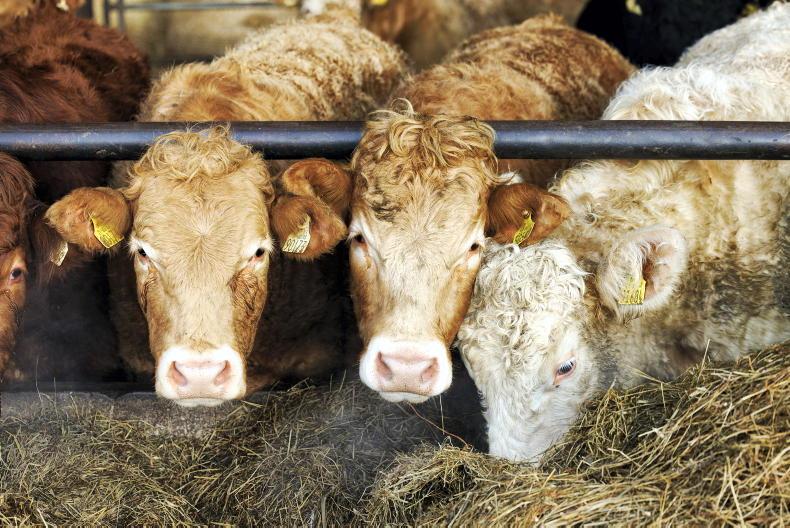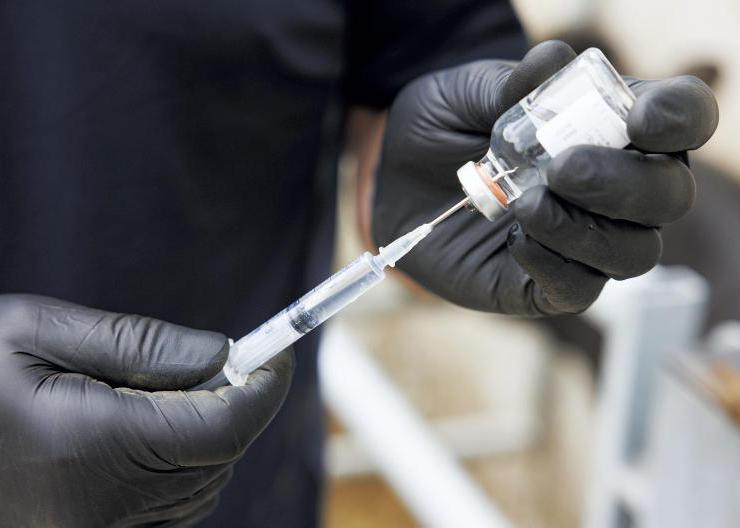There has been a huge increase in the cases of pneumonia on beef farms, especially in weanlings, over the past two weeks.
Cattle are exposed to many stressors this time of year, such as weaning and housing. These stressors negatively impact cattle’s immune system, and they are then susceptible to developing disease, in particular bovine respiratory disease (BRD).
BRD takes in all types of different pneumonias that cattle can contract.
Respiratory disease is the most significant cause of death in cattle that are greater than one month of age in Ireland, each year. I asked Sarah Higgins a few questions around pneumonia and how farmers can treat it and prevent it.
What causes respiratory disease?
“It’s a complex interaction between the animal, pathogens (bacteria, viruses and lungworm) and the environment. Unfortunately, the clinical cases you see on your farm with the classic clinical signs of BRD, such as a fever, coughing and nasal discharge, are only the tip of the iceberg, as many animals are subclinical cases.”
What can you do now to reduce the incidence and severity of BRD cases within your herd?
“It is vital to implement a strategic plan this time of year for weanlings and autumn-born calves to maximise their immunity and minimise infectious pressure, as there are not just short-term implications with BRD, but significant long-term consequences. BRD can negatively affect productivity, as it can reduce feed conversion efficiency and subsequently reduce daily weight gain.”
How can you control the incidence in the herd?
“Controlling BRD incorporates many elements, such as good housing, management, biosecurity and vaccination. It is vital to provide housing with good ventilation and no draughts, for both weanlings and autumn-born calves.
"Air movement within the shed is vital to remove noxious gases, heat, moisture and pathogens, for example, bacteria and viruses.
“Ideally, the long axis of the shed should be at right-angles to the southwest to maximise natural ventilation efficiency. Ensure the shed is sufficiently lighted, as this will help with early detection of disease in calves and will improve therapeutic success.
It is worth noting the thermoneutral zone for calves is 10-25°C, therefore, during autumn/winter, consider deep-bedding and calf-jackets to help maintain their temperature and reduce stressing the calves.”
What about buying in weanlings – is there anything farmers should
be doing?
"In relation to biosecurity, if purchasing weanlings, ideally, they should be kept in a separate shed or a well-sheltered pasture (weather permitting) for at least four weeks. It is advised to monitor recently purchased stock for clinical signs of BRD daily.”
Outline a good vaccination plan for a beef farm
"Vaccination is a key component of control measuring for bovine respiratory disease. Vaccination will stimulate the animal’s immune system and produce antibodies, which will reduce the incidence and severity of respiratory disease within your herd. It is vital to implement a correctly timed vaccination programme.
"It is also recommended to vaccinate in advance of the risk period during housing to enable the animals to respond correctly to the vaccine.
"Vaccination protocols will vary, depending on the product used. For example, Bovilis Bovipast RSP protects against both viral and bacterial agents, namely PI3, RSV and Mannheimia haemolytica.
"The primary course for Bovilis Bovipast RSP involves two subcutaneous injections administered four weeks apart. The second injection should be given two weeks before the known risk period of weaning or housing. For bought-in weanlings Bovilis Bovipast RSP can be administered any time after arrival, ideally allowing a short rest period of 24 hours before handling, then followed up with a second dose four weeks later.
"Bovilis IBR marker live can be administered intranasally or intramuscularly two weeks before the risk period, providing six months’ protection against Bovine herpesvirus 1. It provides the fastest onset of immunity of four days post-intranasal vaccination."
What do I need to do with
autumn-born calves?
"For autumn-born calves, a vaccination protocol to consider – to provide early and fast protection against RSV, PI3 and BCoV – is vaccination with Bovilis INtranasal RSP Live and Bovilis Nasalgen-C on the day of birth. Both vaccines are administered intranasally and provide immunity for a duration of 12 weeks.
"Bovilis Nasalgen-C, recently introduced by MSD Animal Health, is a live intranasal vaccine for the active immunisation of cattle from the day of birth onwards, to reduce clinical signs of upper respiratory tract disease and nasal viral shedding from infection with Bovine coronavirus (BCoV). This vaccine is a 2ml dose, administered intranasally.
"The vaccine has an onset of immunity of five days and a duration of immunity of 12 weeks. BCoV is frequently implicated with mixed infections of respiratory disease, in particular RSV and PI3.
"BCoV opens the respiratory tract to other infectious causes of BRD by reducing the production of mucus formation in the upper respiratory tract. This mucus acts as a defence mechanism against pathogens and debris in healthy animals.
"The above vaccine protocol can be implemented by those farmers who are calving during the housing period also."
Recommendation
for weanlings
pre-housing
Vaccinate all animals in a group pre-housing and newly purchased when settled.Delay housing for a period
post-weaning.Quarantine newly purchased animals.Avoid abrupt weaning/group disruption by removing several cattle.Implement a strategic worming programme during the grazing season, particularly for lungworm.Avoid additional stressors, such as castration at weaning.
Allowing animals a few days to settle after purchasing in mart before dosing or vaccination is completed is best practice.
Recommendation for weanlings at housing
Avoid overcrowding or mixing age groups in the same airspace.Provide ample supply of fresh clean water.Dose animals after housing with an appropriate anthelmintic, and consider fluke control if this is relevant to the animals’ risk profile.House on a dry day.Have adequate lighting in sheds, so sick animals can be detected early, while also helping animals to find feed and water in their new environment.Isolate sick animals and treat appropriately.Quarantine newly purchased animals.
There has been a huge increase in the cases of pneumonia on beef farms, especially in weanlings, over the past two weeks.
Cattle are exposed to many stressors this time of year, such as weaning and housing. These stressors negatively impact cattle’s immune system, and they are then susceptible to developing disease, in particular bovine respiratory disease (BRD).
BRD takes in all types of different pneumonias that cattle can contract.
Respiratory disease is the most significant cause of death in cattle that are greater than one month of age in Ireland, each year. I asked Sarah Higgins a few questions around pneumonia and how farmers can treat it and prevent it.
What causes respiratory disease?
“It’s a complex interaction between the animal, pathogens (bacteria, viruses and lungworm) and the environment. Unfortunately, the clinical cases you see on your farm with the classic clinical signs of BRD, such as a fever, coughing and nasal discharge, are only the tip of the iceberg, as many animals are subclinical cases.”
What can you do now to reduce the incidence and severity of BRD cases within your herd?
“It is vital to implement a strategic plan this time of year for weanlings and autumn-born calves to maximise their immunity and minimise infectious pressure, as there are not just short-term implications with BRD, but significant long-term consequences. BRD can negatively affect productivity, as it can reduce feed conversion efficiency and subsequently reduce daily weight gain.”
How can you control the incidence in the herd?
“Controlling BRD incorporates many elements, such as good housing, management, biosecurity and vaccination. It is vital to provide housing with good ventilation and no draughts, for both weanlings and autumn-born calves.
"Air movement within the shed is vital to remove noxious gases, heat, moisture and pathogens, for example, bacteria and viruses.
“Ideally, the long axis of the shed should be at right-angles to the southwest to maximise natural ventilation efficiency. Ensure the shed is sufficiently lighted, as this will help with early detection of disease in calves and will improve therapeutic success.
It is worth noting the thermoneutral zone for calves is 10-25°C, therefore, during autumn/winter, consider deep-bedding and calf-jackets to help maintain their temperature and reduce stressing the calves.”
What about buying in weanlings – is there anything farmers should
be doing?
"In relation to biosecurity, if purchasing weanlings, ideally, they should be kept in a separate shed or a well-sheltered pasture (weather permitting) for at least four weeks. It is advised to monitor recently purchased stock for clinical signs of BRD daily.”
Outline a good vaccination plan for a beef farm
"Vaccination is a key component of control measuring for bovine respiratory disease. Vaccination will stimulate the animal’s immune system and produce antibodies, which will reduce the incidence and severity of respiratory disease within your herd. It is vital to implement a correctly timed vaccination programme.
"It is also recommended to vaccinate in advance of the risk period during housing to enable the animals to respond correctly to the vaccine.
"Vaccination protocols will vary, depending on the product used. For example, Bovilis Bovipast RSP protects against both viral and bacterial agents, namely PI3, RSV and Mannheimia haemolytica.
"The primary course for Bovilis Bovipast RSP involves two subcutaneous injections administered four weeks apart. The second injection should be given two weeks before the known risk period of weaning or housing. For bought-in weanlings Bovilis Bovipast RSP can be administered any time after arrival, ideally allowing a short rest period of 24 hours before handling, then followed up with a second dose four weeks later.
"Bovilis IBR marker live can be administered intranasally or intramuscularly two weeks before the risk period, providing six months’ protection against Bovine herpesvirus 1. It provides the fastest onset of immunity of four days post-intranasal vaccination."
What do I need to do with
autumn-born calves?
"For autumn-born calves, a vaccination protocol to consider – to provide early and fast protection against RSV, PI3 and BCoV – is vaccination with Bovilis INtranasal RSP Live and Bovilis Nasalgen-C on the day of birth. Both vaccines are administered intranasally and provide immunity for a duration of 12 weeks.
"Bovilis Nasalgen-C, recently introduced by MSD Animal Health, is a live intranasal vaccine for the active immunisation of cattle from the day of birth onwards, to reduce clinical signs of upper respiratory tract disease and nasal viral shedding from infection with Bovine coronavirus (BCoV). This vaccine is a 2ml dose, administered intranasally.
"The vaccine has an onset of immunity of five days and a duration of immunity of 12 weeks. BCoV is frequently implicated with mixed infections of respiratory disease, in particular RSV and PI3.
"BCoV opens the respiratory tract to other infectious causes of BRD by reducing the production of mucus formation in the upper respiratory tract. This mucus acts as a defence mechanism against pathogens and debris in healthy animals.
"The above vaccine protocol can be implemented by those farmers who are calving during the housing period also."
Recommendation
for weanlings
pre-housing
Vaccinate all animals in a group pre-housing and newly purchased when settled.Delay housing for a period
post-weaning.Quarantine newly purchased animals.Avoid abrupt weaning/group disruption by removing several cattle.Implement a strategic worming programme during the grazing season, particularly for lungworm.Avoid additional stressors, such as castration at weaning.
Allowing animals a few days to settle after purchasing in mart before dosing or vaccination is completed is best practice.
Recommendation for weanlings at housing
Avoid overcrowding or mixing age groups in the same airspace.Provide ample supply of fresh clean water.Dose animals after housing with an appropriate anthelmintic, and consider fluke control if this is relevant to the animals’ risk profile.House on a dry day.Have adequate lighting in sheds, so sick animals can be detected early, while also helping animals to find feed and water in their new environment.Isolate sick animals and treat appropriately.Quarantine newly purchased animals. 










SHARING OPTIONS